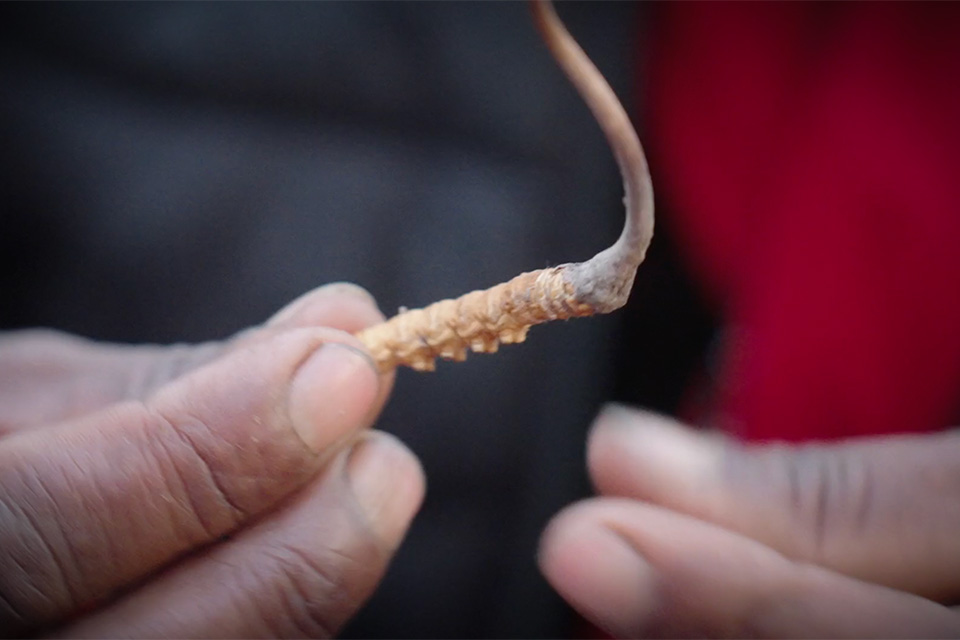Synopsis
In highland Nepal, collecting caterpillar fungus is a crucial part of fragile livelihoods, providing up to 80% of household incomes. At the same time, the fungus is part of a broader and often overlooked story: Over the past two decades, myths surrounding caterpillar fungus have fueled demand in China, transforming it from a little-known remedy into a symbol of wealth and health. This shift made it the most valuable fungus in the world and tied Himalayan foragers into the vicissitudes of the “Chinese dream.” The fungus’s journey embodies a key paradox of modernity. It links precarious dreams and modern anxieties.


Starting point
In highland Nepal, caterpillar fungus foraging provides a fragile livelihood - yet it reveals power dynamics that few recognise. Over the past two decades, myths surrounding this fungus have fuelled soaring demand in China, where it has evolved into a luxurious gift for the elite. This shift has elevated its status into a symbol of power and prestige, making it the most valuable fungus in the world. This unfolding narrative places Himalayan foragers in direct tension with the ambitions of the “Chinese dream.” While the project explores the themes of power, growth, and environmental change tied to China’s rise, centring the story on the fungus reveals deeper entanglements between humans and fungi. How does this organism connect such distant lives, and what gives it the power to define these worlds?
The caterpillar fungus’ journey
The life cycle of the caterpillar fungus becomes a metaphor for entangled worlds: fungal spores parasitise small larvae, culminating in an animal-fungi hybrid and emerging as delicate mushrooms in the summer grass. In western Nepal, hundreds of people began to depend on this precarious mushroom hunt. Each spring, entire families climb up to 5000 meters and stay in improvised tent cities. We are following Dhaniman and his family. Each mushroom they find helps keep their daughter in school. In the valley below, Karma, a local trader, inspects the harvested fungus, teaching his son to attune his senses to the subtle nuances of its size, colour, and shape. Yet the trader’s world is no less uncertain. It’s Karma’s turn to connect worlds, transporting the fungus by helicopter to Kathmandu, where it begins to take on its unfamiliar form.

From Camps to the Lab
In China, the caterpillar fungus enters a different world, where laboratories and markets reshape its identity. Scientists breed caterpillars in secret labs, perfecting techniques for artificial cultivation. Meanwhile, a wealthy trader brands the fungus as a high-end health supplement, marketed for its anti-ageing and aphrodisiac properties. Far removed from its highland origins, the fungus embodies the allure of untamed nature reimagined as a luxury item. As we see the organism move through these environments, sometimes reaching prices up to 100.000 EUR per kilogram, its journey raises questions: Does the world notice how the life cycle of a small organism has become a subject of fascination and value? What ultimately turns it into such a powerful symbol?
The journey of the fungus becomes a window into the complexities of China’s modernity, where narratives of progress collide with fragile environments, chaotic realities, and a longing for nature. As the promise of virility and a mythical cure, the fungus reveals the paradox behind the relentless pursuit of a future that never seems to arrive.

Outcomes
What insights can these mushrooms offer about our world? The fungus’s journey provides the research’s framework that creates a space for stories that invite us to think through global connections. The current project is being developed as a feature-length documentary film and as a part of a multimodal sensory media exhibition.
